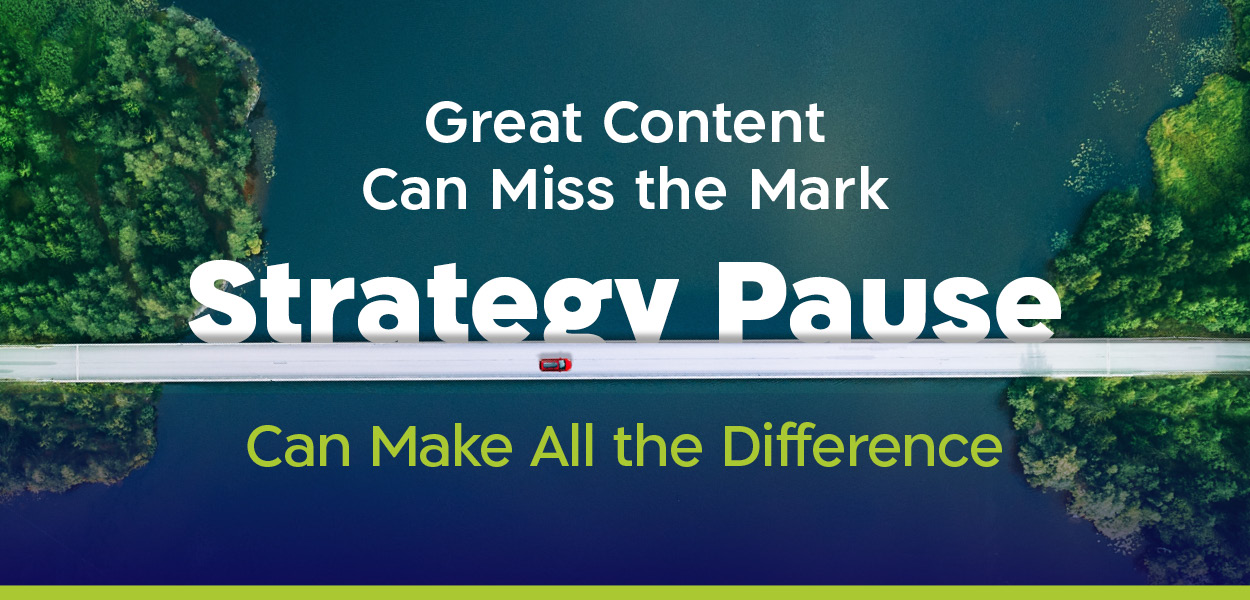September 22, 2024

Even the most well-crafted content can sometimes fail to deliver the results you want. As our world gets more digital, it’s not uncommon for businesses to pour money and time into creating high-quality content, blogs, videos, social media posts, and eye-catching designs, only to find that their efforts don’t connect with their target audience or drive results. In most cases, this isn’t a reflection of the campaign’s quality, but a sign that it simply doesn’t align with the company’s “big picture” and goals.
Consider this: A company puts together an insightful blog post packed with valuable information and engaging visuals or an expert educational webinar. The problem is, if that campaign isn’t aligned with the brand’s broader marketing goals and strategy or tailored to the specific needs and behaviors of its audience, it’s likely to miss the mark. Without a strategic framework guiding planning, production, and distribution, even the best campaign can get lost in the noise of the internet, failing to generate traffic, engagement, or conversions.
Your campaign could have all the right elements in place – compelling storytelling, high production values, and a strong call to action, but without the strategic groundwork, it is likely to struggle to achieve meaningful results.
Why Often Misses the Mark?
Creating digital content that truly connects with your audience is no small feat. The landscape is crowded, the competition is intense, and audiences are more critical than ever. While many businesses pour resources into content creation, they find that their efforts do not translate into engagement or conversions. Most of the time, it’s just a lack of alignment between content and the organization’s overall business goals. Without a clear, strategic framework, content can become scattered, inconsistent, and ultimately ineffective.
This is exactly why companies should consider stepping back to take a broader view. Rather than rushing ahead with the next campaign or content piece, a strategic pause to reassess and realign can be incredibly valuable.
This is the essence of the discovery and study processes, a strategic approach that will build a solid foundation for your digital marketing campaign.
Understanding the Study Process
The primary aim of the Study process is to provide a focused analysis of your current digital marketing efforts. It’s about taking a step back and evaluating what’s working and what isn’t, allowing for strategic adjustments that enhance performance. This process is ideal for annual strategy reviews, specific campaign assessments, or when there’s a need to refresh the approach to your digital marketing.
What It Achieves?
The Study process delivers actionable insights that help fine-tune your digital strategy. By concentrating on specific areas, such as target audience engagement, campaign effectiveness, or digital content performance, the Study process allows businesses to make data-driven decisions that improve ROI. It helps you understand where your content may be falling short and offers concrete steps to address these issues.
How It’s Done?
- Initial Consultation: In-depth session to clarify your business’s current digital marketing objectives and identify the key areas that require attention.
- Targeted Research: Assessing the performance of specific campaigns, audience engagement metrics, and the effectiveness of your content in driving desired outcomes.
- Strategy Refinement: Adjust and optimize existing strategies based on findings.
- Implementation and Monitoring: Monitoring and tweaking the revised strategy as needed.
Example: A company uses the Study process for an annual strategy review, identifying gaps in campaign performance and refining their approach to improve results.
Exploring the Discovery Process
The Discovery process offers a broader, more comprehensive approach to digital strategy development. It’s designed for businesses that are launching new brands, undergoing a rebrand, or expanding into new markets. The Discovery process is about building a solid strategy that aligns with long-term business goals and keeps consistency across all digital channels.
The Discovery process offers a deep dive into your brand’s identity, your market, and your audience. It provides a holistic understanding of your brand’s digital landscape. It uncovers opportunities for differentiation, identifies potential challenges, and sets a strategic direction that makes sure all digital efforts are aligned with your overarching business goals.
One of the unique offerings of the Discovery process is the development of a visual language for your digital activities. This component ensures that your brand communicates consistently and effectively across all platforms, enhancing brand recognition and coherence, which is not typically included in the Study process.
The goal is to develop a strategy that meets immediate needs as well as positions your brand for long-term success. This process is particularly beneficial for companies preparing for major changes, such as a new brand launch or market expansion.
How It’s Done?
- Kick-off Meeting: Clarify goals and challenges.
- Comprehensive Research and Analysis: A thorough examination of the market, competitors, and internal capabilities. Key activities include identifying Buyer Personas, conducting a Competitive Digital Analysis, and performing a detailed SEO review.
- Digital Strategy Development: Based on the research insights, a full-scale digital strategy is formulated. This includes defining content pillars, creating a media plan, and developing creative visual guidelines that ensure brand consistency across all platforms.
- Presentation and Implementation: Once approved, the strategy is implemented, with ongoing support to ensure its success.
Example: A company undergoing rebranding uses Discovery to align its digital presence with its new identity, resulting in a cohesive and impactful digital strategy.
Why Discovery Is the Better Choice?
While both the Study and Discovery processes offer valuable insights and strategic direction, the Discovery process stands out as the more comprehensive and long-term solution. Here’s why Discovery might be the better choice for most businesses:
Long-Term Strategic Value
Discover aims to build a digital strategy that will serve your business for years to come, not just address immediate needs. By conducting thorough research and analysis, the Discovery process helps you create a strong, adaptable strategy that can evolve with your business. This long-term focus is particularly valuable in today’s fast-paced digital environment, where trends and technologies are constantly changing.
Comprehensive Insights
Unlike the Study process, which offers a more focused review, the Discovery process provides a holistic view of your digital strategy. This includes everything from a detailed SEO review to the development of creative visual language guidelines. These insights are crucial for making sure that all aspects of your digital presence. From content to design, everything is aligned with your brand’s goals.
Flexibility and Customization
One of the key benefits of the Discovery process is its flexibility. The process can be adjusted to your specific needs – whether you’re launching a new product line, rebranding, entering a new market, or looking to create a unified visual identity for your campaigns. This customization helps make sure that your digital program is relevant, consistent, and effective.
With the digital marketing arena being so fast-paced, it’s easy to get caught up in the rush to produce content and launch campaigns.
Taking the time to reassess your digital strategy allows you to see what’s really working and where you might need to adjust course. It’s not simply about tweaking a campaign here or there, but rather making sure that every piece of content you create is connected to your broader goals and truly resonates with your audience.
Whether you’re considering the focused approach of the Study process or the more comprehensive Discovery process, this strategic pause is crucial so your content doesn’t just reach your audience—it makes an impact.















 As a company that leads Israeli B2B companies to success in the global market, we’ve developed a structured five-step process to ensure marketing directly advances the company’s business decisions.
As a company that leads Israeli B2B companies to success in the global market, we’ve developed a structured five-step process to ensure marketing directly advances the company’s business decisions.
 The beauty of this process lies in its clarity. Every marketing effort is measured by its direct contribution to the business. If it’s not in the plan, there’s a reason.
It may sound simple - and it is - but it requires you to pause, plan, and sometimes partner with an external professional. Someone who will hold you accountable, challenge your thinking, and keep you focused. Someone who’s done this many times before and knows how to steer the process.
The cheetah doesn’t wait - and the year won’t either. Now is the time to focus your marketing on what truly matters for your business and drive real impact. We’re here to help.
The beauty of this process lies in its clarity. Every marketing effort is measured by its direct contribution to the business. If it’s not in the plan, there’s a reason.
It may sound simple - and it is - but it requires you to pause, plan, and sometimes partner with an external professional. Someone who will hold you accountable, challenge your thinking, and keep you focused. Someone who’s done this many times before and knows how to steer the process.
The cheetah doesn’t wait - and the year won’t either. Now is the time to focus your marketing on what truly matters for your business and drive real impact. We’re here to help.





